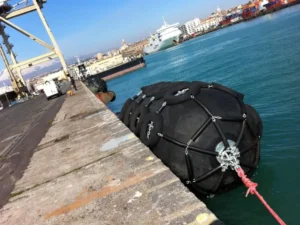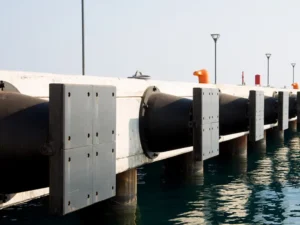Dans le secteur maritime, les défenses sont d'une importance capitale. Leur utilisation sauve les armateurs et les pilotes de navires. Sans elles, le voyage du navire est impossible. Il existe cependant différents types de défenses, dont les défenses en caoutchouc. Mais la question est de savoir ce qu'est le caoutchouc et pourquoi il est si populaire.
Je crois savoir que cette question est bien comprise par de nombreuses personnes associées à l'industrie maritime. Cependant, certains débutants dans ce domaine semblent être confus. Même si vous êtes un passionné du secteur maritime, connaissez-vous la raison de la popularité de ces défenses ? Je parie que non ! Commençons donc par discuter en détail des défenses en caoutchouc.
Aperçu des défenses en caoutchouc

Les défenses en caoutchouc sont comme des pare-chocs, mais pour les bateaux, les navires et les embarcations. Elles agissent comme des gardes de sécurité pour les navires, les protégeant des dommages pendant l'accostage. Ces défenses sont fabriquées en caoutchouc et restent suspendues autour du navire. Elles entrent en collision avec la structure d'amarrage et absorbent l'impact.
Il existe différents types de défenses en caoutchouc pour les navires. Cependant, ils ont tous la même fonction : protéger les navires. Bien que leur qualité varie d'un type à l'autre, chaque type présente des caractéristiques uniques. Elles sont conçues pour servir des navires de tailles et de hauteurs différentes.
Leur utilisation est très répandue et remonte à plusieurs décennies. Autrefois, le bois était le principal Matériau utilisé pour la fabrication des ailes. Mais ces garde-boue en bois n'étaient pas très efficaces. En effet, le bois n'absorbant pas les chocs, son efficacité était compromise.
L'introduction d'un matériau en caoutchouc dans les garde-boue s'avère pratique. En effet, ce matériau absorbe les chocs. Lorsqu'un navire entre en collision avec une structure d'amarrage, ces défenses en caoutchouc absorbent l'énergie cinétique. Par conséquent, le bateau ne subit aucune secousse ni aucun choc soudain. En outre, les flancs des navires restent en sécurité car les défenses touchent d'abord les structures d'amarrage.
Résumé rapide : Les défenses en caoutchouc ont pour principal objectif de sauver les navires et les embarcations. Elles y parviennent de deux manières. Premièrement, elles absorbent les chocs, ce qui est un grand avantage. D'autre part, elles amorcent les collisions avec les structures d'amarrage, de sorte que le corps du navire reste à l'abri des collisions à grande vitesse.
Caractéristiques des défenses en caoutchouc

Dans l'introduction, j'ai mentionné que ces garde-boue étaient à la mode. La question est de savoir pourquoi. La réponse à cette question est liée aux caractéristiques de ces garde-boue. Approfondissons la question et explorons les propriétés essentielles de ces garde-boue. En les comprenant, vous saurez pourquoi elles sont si à la mode.
1- L'élasticité
Tout d'abord, le caoutchouc est très élastique. Si vous l'étirez avec force, il reprendra sa forme initiale et ne se déformera pas de façon permanente. Cela est dû à sa longue chaîne de polymères, qui est très flexible. Lorsque le caoutchouc est utilisé dans les garde-boue, ceux-ci deviennent élastiques. Cette élasticité leur permet d'absorber et de dissiper l'énergie avec facilité.
Imaginez un navire qui vient s'amarrer aux structures d'accueil. Il arrive avec une certaine vitesse. Lors de son approche, les défenses entrent d'abord en collision avec les structures d'amarrage. Cette collision produit de l'énergie cinétique. Les défenses en caoutchouc absorbent toute l'énergie et se déforment et se compriment.
Cependant, cette déformation ou compression des ailes en caoutchouc n'est pas un problème majeur. Grâce à leur élasticité, ces défenses reprennent facilement leur forme initiale. En outre, elles protègent les structures d'amarrage contre les dommages.
2- Durabilité et résistance
Les défenses en caoutchouc restent dans l'eau salée. Il n'est pas faux de dire qu'ils passent une grande partie de leur vie dans l'eau. De plus, ils sont confrontés à des conditions météorologiques extrêmes. Comment oublier leur exposition à la lumière extrême du soleil et aux rayons UV ? Lorsqu'elles sont installées sur un navire, elles sont soumises à des conditions sévères.
Mais ils restent en bon état sans se détériorer. La raison en est que le caoutchouc utilisé pour ces garde-boue est de la plus haute qualité. Sa résistance aux différentes conditions environnementales est excellente. Mais il faut toujours acheter des ailes auprès d'un fabricant réputé.
Il vous aidera à acheter des garde-boue solides et fiables, fabriqués avec des matériaux de haute qualité. Ne tombez pas dans le piège des fabricants bon marché qui font des compromis sur la qualité. Cela deviendrait un casse-tête et votre argent serait constamment menacé.
3- Résistance à la traction
La résistance à la traction est une caractéristique essentielle qui les rend très populaires. Comprenons d'abord ce que ce terme signifie. Il s'agit de la force maximale qu'un matériau peut supporter sans se détériorer ou se rompre. Les garde-boue en caoutchouc ont une résistance à la traction élevée, ce qui leur permet de se démarquer en cas de collision intense.
Par exemple, si le navire s'approche d'un quai à grande vitesse, les défenses subiront davantage de collisions. Dans ce cas, la haute résistance à la traction est très utile. Elle permet aux défenses de se déformer sans se casser ni se détériorer. Par conséquent, les garde-boue restent en bon état même après une collision intense. Ces caractéristiques font que les ailes en caoutchouc sont très appréciées.
4- Résistance à la compression
Il s'agit d'une autre caractéristique importante qui permet aux garde-boue en caoutchouc de se démarquer. Comprenons ce que signifie cette caractéristique. Elle indique simplement que les garde-boue se rétablissent après avoir été soumis à une compression pendant une période prolongée. Certains caoutchoucs de qualité médiocre se bloquent et se déforment lorsqu'ils sont soumis à une compression prolongée.
Cela affecte les performances des garde-boue en caoutchouc. C'est pourquoi j'insiste toujours sur le choix d'un garde-boue en caoutchouc de haute qualité. De telles ailes en caoutchouc peuvent reprendre leur forme, quelle que soit la durée de leur compression. Cette caractéristique permet aux ailes en caoutchouc d'être prêtes à affronter les chocs et les secousses les plus violents. Le caoutchouc des garde-boue ne se coince pas lors d'un impact.
Fonctionnement des défenses en caoutchouc
Le fonctionnement des défenses en caoutchouc repose sur deux caractéristiques : l'élasticité et la résistance à la traction. Un caoutchouc dont l'élasticité est compromise ne sera jamais performant lorsqu'il est utilisé dans ces défenses. N'oubliez pas que ces défenses peuvent être installées sur des structures d'amarrage et des navires.
Comprenons comment fonctionnent ces défenses marines en caoutchouc. Le navire ou le bateau s'approche des structures d'amarrage pour y séjourner. Il se rapproche du quai à une certaine vitesse. Si le navire entre rapidement en collision avec le quai, le navire et le quai seront endommagés par la collision.
Ces défenses sur le navire agissent comme des barrières. Elles empêchent les collisions directes des navires avec les quais. Au contraire, lorsque le bateau s'approche du quai, la défense en caoutchouc entre en collision avec la structure d'accueil. Il faut garder à l'esprit que les défenses sont compressibles et élastiques. Elles absorbent donc l'impact de la collision en absorbant l'énergie cinétique.
Les défenses dissipent ensuite l'énergie. Comme elles absorbent l'impact, le navire ne ressent aucune secousse importante et reste en sécurité. En raison de leur nature élastique, les défenses se compriment et reprennent leur forme initiale. Ces défenses en caoutchouc jouent donc un rôle essentiel dans l'industrie maritime.
Types de défenses en caoutchouc

Il existe différents types de garde-boue en caoutchouc. Chacun d'entre eux varie en termes de propriétés et de performances. En outre, le processus d'installation des défenses en caoutchouc diffère également de manière significative. Voici la liste de ces types :
- Défenses de type D
- Défenses Super Cell
- Super Arch Fenders
- Défenses en caoutchouc ME
- Défenses Super Cone
- Défenses cylindriques en caoutchouc
Il est important de noter que tous ces garde-boue ont la même fonctionnalité. Cependant, leurs caractéristiques et leurs opérations les rendent différentes. Comme indiqué précédemment, toutes les défenses en caoutchouc ont des formes et des tailles uniques, ce qui les rend adaptées à différents navires et bateaux.
Les bouées et les défenses sont-elles identiques ?
Non, les bouées et les défenses ne sont pas identiques. Elles ont des fonctions différentes. Les défenses sont des pare-chocs de sécurité qui protègent le navire lorsqu'il entre en collision avec le quai. En revanche, les bouées sont des signaux d'avertissement qui indiquent un passage sûr en mer.
Les bouées sont généralement utilisées lorsque le navire doit rester en mer. Elles sont ancrées dans le fond marin et maintiennent le bateau au même endroit. Les capitaines utilisent généralement les bouées pendant les tempêtes et les mauvaises conditions météorologiques. Elles les aident à maintenir le navire au même endroit. Il existe différents types de bouées pour les bateaux.
Les défenses sont différentes des bouées. Elles sont installées sur les côtés des bateaux ou des navires. Elles peuvent être retirées et placées à l'intérieur du bateau lorsqu'elles ne sont pas utilisées. Lors de l'accostage, elles assurent la sécurité des navires. Tout comme les bouées, il existe de nombreux types de défenses.
Questions fréquemment posées
Quel est le matériau utilisé par Fender ?
Le caoutchouc est le principal matériau utilisé pour la fabrication de la plupart des garde-boue. En général, ce matériau est excellent pour absorber l'énergie cinétique produite lors d'une collision. Ce qui le rend populaire, c'est son rapport coût-efficacité.
Qu'est-ce qu'une aile en caoutchouc ?
Il s'agit d'éléments de protection installés sur les navires ou les bateaux. Ils sont élastiques et fabriqués en caoutchouc. Ils se distinguent par leur capacité à absorber les chocs et les secousses.
Quel est le meilleur matériau pour les ailes ?
Différents matériaux sont disponibles pour la fabrication des défenses. Toutefois, je considère que le caoutchouc est le meilleur matériau pour les défenses marines. Il est peu coûteux et efficace, et se distingue par son élasticité et sa résistance à la traction.
Les défenses de voiture et de bateau sont-elles différentes ?
Oui, les ailes des voitures sont généralement en plastique. Elles sont fragiles et ne résistent pas aux chocs. En revanche, les défenses marines sont robustes et durables. Elles sont parfaites pour supporter facilement des forces et des pressions extrêmes.
À quoi servent les housses d'ailes et quand doivent-elles être utilisées ?
Les housses d'ailes protègent les ailes, agissant comme un bouclier supplémentaire ou une couche de sécurité. Grâce aux housses, la lumière du soleil et les expositions aux UV ne peuvent pas affecter la qualité du caoutchouc de ces ailes.
Conclusion
Les défenses en caoutchouc sont très utiles à bien des égards. Elles protègent à la fois le navire et la structure d'accueil sans se détériorer. Leur excellente élasticité et leur résistance à la traction garantissent leur efficacité. Il existe différents types de défenses en caoutchouc, chacun étant très spécifique. Ce guide couvre tous les détails de ces défenses. Cet ouvrage vous servira de guide.
